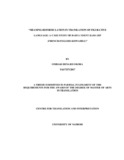| dc.description.abstract | Lately, there has been a lot of expansion and change of education systems, and due to the rapid changes and more often to the literature review, books that had been originally written in foreign languages are translated and inculcated to the education systems as set books or revision books. These has expanded the number of authors in play, some of whom have their literally works heavily influenced by their use of figurative language. So what approach to translators use in such cases, and of importance, how do they ensure that fidelity to the source criteria is maintained? Striking a balance between effectively communicating with a target audience where figurative language influence language use and fidelity to the message becomes a bottleneck to translators. So how does a translator get over this?
Equivalence in translation becomes the only resort. But on the other hand, this figurative language could be unique to the SL, which prompts us to grill the approaches employed by translators in coming up with equivalents and whether those equivalents bring out the same meaning of the SL. This is the main focus of this research.
Finding equivalents during translation that suit the target culture especially in the use of figurative language, instead of opting for a word-for-word translation demands a strong judgment and comprehension of the linguistic and cultural patterns of the target audience. This can equally be too much involving especially when a translator is working on a time limit. A translator is therefore under obligation to make a precautious approach when dealing with figurative language especially in an interlingual translation where both languages are of different origins.
Barua ndefu kama hii (Maganga, 1994), is a Swahili translation of So long a letter (Modupe, 1981). This English translation was published just one year after the publication of the original novel Une si longue lettre (Mariama, 1980). Barua ndefu kama hii (Maganga, 1994) was published fourteen years after the original publication in French and thirteen years after the first translation of the original book into English.
In this study, we set to find out if the Swahili translation faced any challenges in finding the translation equivalents while translating figurative language and the strategies that the translator employed. The main objective of this research is to investigate how meaning is reformulated during an interlingual translation. We will be guided by the theory of dynamic equivalence as opposed to formal equivalence, as we seek to unearth the meaning reformulations in similes and metaphors‟ translations, in order to ensure that interlingual translations do not lose meaning of these core figurative speeches in the process | en_US |



